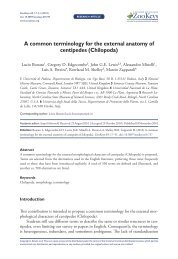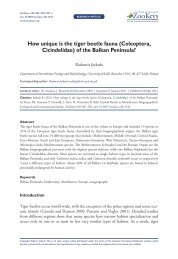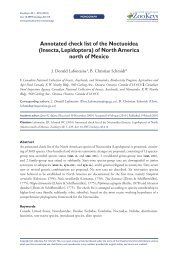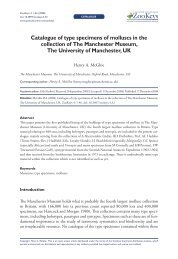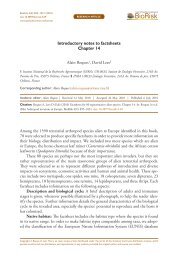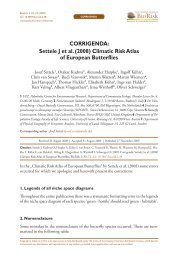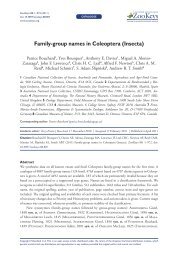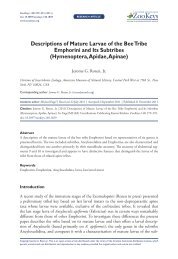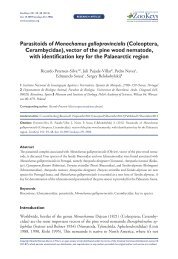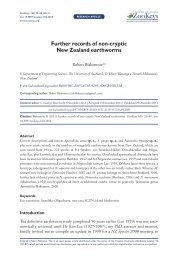Formicdubius Philips & Scholtz from South Africa, a junior synonym ...
Formicdubius Philips & Scholtz from South Africa, a junior synonym ...
Formicdubius Philips & Scholtz from South Africa, a junior synonym ...
You also want an ePaper? Increase the reach of your titles
YUMPU automatically turns print PDFs into web optimized ePapers that Google loves.
44<br />
Frank-Th orsten Krell & T. Keith <strong>Philips</strong> / ZooKeys 34: 41–48 (2010)<br />
Th e trichomes on these species are located on the mesepisternum anterolaterally,<br />
the elytra anterolaterally (on the vertical surface facing the pronotum), and on the<br />
pronotal base posterolaterally. One should be aware that these setae may be damaged<br />
<strong>from</strong> the eff ects of gnawing by their host ants and the actual number of setae may vary<br />
in number more than we report due to our limited sample sizes. Regardless, the degree<br />
of development of these structures in each species is as follows:<br />
Specimens of H. ennearthrus possess a large rounded cluster of setae on the<br />
mesepisternum (Fig. 19) and no additional setae proximally. Th ey also appear to have<br />
two short and relatively thick setae on the elytral base. Th ree to fi ve thick setae are<br />
present on the pronotum (Figs 16–18) as well as a row of similar aligned setae proximal<br />
to these, all of which may be trichomes (Fig. 16).<br />
Haroldius modestus (Figs 7–10) also has a large, rounded cluster of setae on the<br />
mesepisternum (Fig. 10) and lacks any thick setae proximally. Th ere are two to three<br />
thick setae on the elytral base. On the pronotum a brush-like trichome is well developed,<br />
consisting of six to sometimes ten or more, long, thick setae (Figs 8–9).<br />
Th e third described Haroldius species <strong>from</strong> <strong>Africa</strong>, H. leleupi (Figs 11–13), is<br />
strikingly similar to <strong>Formicdubius</strong> convexus (Figs 1–6). Th ey both have a small cluster<br />
of stout setae on the mesepisternum (Figs 6, 13) and proximal to this are a few<br />
more thick and elongate setae arranged in a transverse row (Fig. 6). Th ese same<br />
setae become more slender and slightly more widely separated the further <strong>from</strong> the<br />
mesepisternal trichome. Additionally, there are four to fi ve short, thick setae at the<br />
base of the elytra near the lateral margin (Fig. 5). Both species also have a well developed<br />
trichome on the pronotal base consisting of 20 or more lobe shaped setae<br />
(Figs 3–4, 12–13).<br />
We are unsure whether H. leleupi and F. convexus are distinct taxa. H. leleupi is<br />
generally larger; the fi ve specimens studied measure 1.80–2.20 mm in length (average<br />
2.06 mm), whereas the 14 sampled types of F. convexus measure 1.63–1.90 mm (average<br />
1.78 mm). Haroldius leleupi also has slightly stronger (more clearly defi ned) punctures<br />
on the disk of the pronotum and the elytral intervals and slightly deeper elytral<br />
striae, particularly near the suture. Additional material will be required <strong>from</strong> localities<br />
between the Congo and <strong>South</strong> <strong>Africa</strong> to decide to what extent these minor diff erences<br />
indicate taxonomic diff erentiation.<br />
Synonymy<br />
Haroldius leleupi and <strong>Formicdubius</strong> convexus are diffi cult to distinguish at the species<br />
level, but there is no doubt that <strong>Formicdubius</strong> is identical with Haroldius at the generic<br />
level. <strong>Formicdubius</strong> fully matches Boucomont’s (1914) original description of<br />
Haroldius. It also agrees with the extended diagnosis of Haroldius recently published<br />
by Krikken and Huijbregts (2006) with the exception that all <strong>Africa</strong>n species currently<br />
subsumed under Haroldius possess trichomes.



